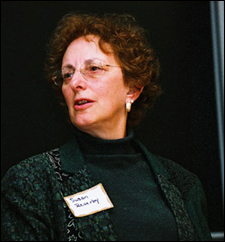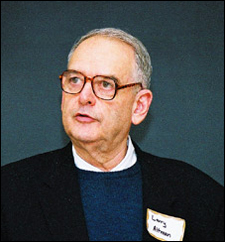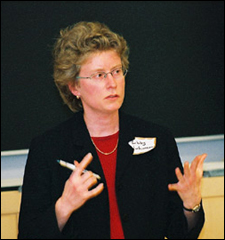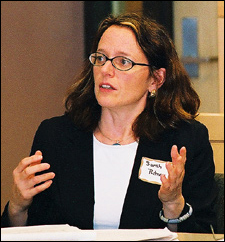Scientists discuss experiments on self


Yes, “self-experimentation” is exactly what it sounds like. It’s when a researcher uses him- or herself as the (or one of the) subjects of an experiment. A recent gathering at the School of Public Health (HSPH) looked into the practice in a discussion titled “Self-Experimentation by Investigators: Panel and Case Discussion.” The exchange produced a robust examination of the relationship between good ethics and rigorous science, between junior and senior investigators, and between scientists and institutional review boards (IRBs). The March 26 event, sponsored by the School’s Human Subjects Committee (HSC), drew researchers and IRB members from across Harvard, as well as from other universities and hospitals.
Moderator Greg Koski, senior scientist at Massachusetts General Hospital and former director of the U.S. Office for Human Research Protections, introduced speaker Lawrence Altman, The New York Times medical columnist and author of the book “Who Goes First?: The Story of Self-Experimentation in Medicine.” According to Altman, self-experimentation is a “historical tradition” that is much more widespread in medicine than acknowledged. Its practitioners have included Nobel Prize winners as well as deans of medical and public health schools, he said.
Examples of self-experimentation range from physician Santorio Santorio’s 30-year, daily measurements of his weight, food intake, and bodily waste in the 16th century, to physician and physiologist Werner Forssmann’s experiments in 1929 and 1935 in which he inserted a catheter into a vein in his arm and pushed the tube up into his heart (he later won a Nobel Prize), to less harrowing contemporary practices such as blood draws, knee MRIs, and urine analyses.
Said panelist Robert Banzett, associate professor in the Department of Environmental Health at HSPH: “Scientists very often want to be subjects. We’re curious. We’re explorers.”
As Altman noted, much self-experimentation took place before the development of regulations, ethical guidelines about human research subjects, or IRBs.


“IRBs were created,” he noted, “because leading scientists committed serious ethical breaches.” One such alleged breach was a notorious U.S. Public Health Service project known as the Tuskegee Syphilis Study. A questioning of the ethics of the study helped lead to the establishment of IRBs, which act in part to protect volunteers from risk, coercion, or undue influence – volunteers who may include the researchers themselves.
Some IRBs have categorically excluded investigators from their own experiments; others have considered the issue case by case. Altman asked the question, “Why should the investigator not be included as a volunteer, where possible, under the assumption that the risk of the experiment cannot be measured?” He argued that the willingness of the investigator to undergo the experiment would serve as an example of “the golden rule” of “do unto others as you would have done unto you” and as a means of reassuring other potential study volunteers.
Panelist Susan Reverby, professor of women’s studies at Wellesley College and editor of “Tuskegee’s Truths: Rethinking the Tuskegee Syphilis Study,” challenged Altman’s notion that scientists’ willingness to take part in their own experiments can be used as a means test for other participants.
Rather than invoking the golden rule, Reverby argued, “there is at least a danger here of what might be called the pyrite rule – that is, the fool’s gold rule. Doing unto others what you might do unto yourself is hubris, and dangerous, because it posits a form of equality that doesn’t always exist.”
A researcher’s motivations for undergoing experimentation may – and often will – differ substantially from those of a lay subject, she asserted. The participant may have a different set of concerns, understanding of risk, or level of willingness to undertake risk. Reverby touched on what she sees as bravado in science, noting that the Public Health Service had a long history of self-experimentation and had erected a wall devoted to individuals whom she described as “killed in action” – researchers who gave their lives for science.


Banzett sees value in self-experimentation. He has conducted respiratory experiments on himself with IRB approval, trying to elucidate in fine detail the mechanics of breathing and the relationship between respiration and the brain. In addition to the “golden rule,” benefits of self-experimentation include providing the researcher with the perspective of a subject, suggested Banzett. He added that there is a practical aspect to self-experimentation – the ease of investigators recruiting, retaining, and monitoring themselves.
Panelist Elizabeth Hohmann, director of Partners HealthCare Human Research Committees, suggested that self-experimentation begged as many practical problems as it solved. She asked, “Why make a problem when none need exist?” It is not essential for investigators to take part in their own studies, she said. If investigators want to gain the perspective of a study participant, they can enroll in someone else’s investigation, she asserted.
The conversation grew even more animated when the discussion turned from principal investigators to other lab members participating – or not – in their lab’s own studies. SPH senior lecturer Richard Cash and SPH research scientist Andrew Binks, both audience members, made the point that protecting lab members from undue pressure is important – but so is maintaining respect for the lab members’ autonomy if they truly wish to participate as subjects in their lab’s studies.
Others raised the issue of coercion or undue influence. “Coercion is easier to spot than undue influence,” said Sarah Putney, director of SPH’s Human Subjects Administration. “It’s not a case of a principal investigator putting a gun to the head” of subordinates, she explained, but of environments where peer pressure may easily develop.




